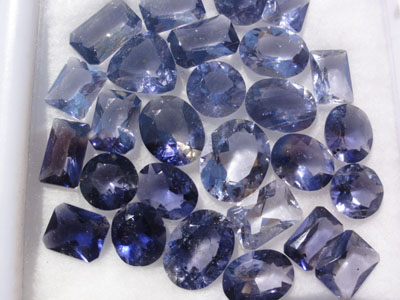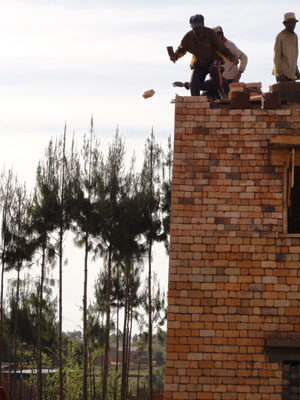












In 2005, 84.9% of the population worked in agriculture, with 80% in livestock, compared to 1.28% in the manufacturing sector and 1.84% in services.
 |
| Vegetable stalls in the countryside |
The general morphology of the Region is characterized by a great potential for exploitable land such as the volcanic regions of Ankaratra, as well as the large plains (Ambohibary in Antsirabe) where the soils, overall, have great fertility.
Soils in the southern zone, consisting of volcanic regions around Ankaratra and Betafo, offer agro-climatic conditions conducive to a variety of crops.
20.4% of the total area of the region is cultivable 50.86% of this area is effectively cultivated
| Total cultivated area | Food crops | Cash crops | Industrial crops | Fruits | Vegetables |
| 215,172 | 210,890 | 351.5 | 2,062 | 2,807 | 1,302 |
| Rice | Cassava | Maize | Sweet potatoes | Potatoes | Beans |
| 69,315 | 13,320 | 55,585 | 17,435 | 33,430 | 23,670 |
The production volume of dominant sectors is as follows:
| Rice | 210,000 tonnes |
| Potatoes | 356,000 tonnes |
| Corn | 65,000 tonnes |
| Cassava | 200,000 tonnes |
| Fruits | 50,000 tonnes |
| Soybeans | 4,030 tonnes |
| Wheat | 2,200 tonnes |
| Barley | 1,850 tonnes |
In 2004, the region exported 9 tonnes of potatoes. See also:
| Cattle Stock | Number of Dairy Cows | TOTAL |
| 329,401 | 18,418 | 347,819 |
 |
| Stones |
Artisanal gold mining is practiced almost everywhere by farmers (Anjoma-Ramartina, Maherikely) in the West of the Betafo sub-prefecture.
| Precious Stones Export | 3,815 kg |
| Fine Stones Export | 652.1 kg |
| Industrial Stones Export | 4,812.2 kg |
| Precious Metals Export | 5.5 kg |
| Precious Stones | Quantity (in grams) | Value in Ariary |
| Raw Stones | ||
| Sapphire | 3,806,520.00 | 14,358,214,090.40 |
| Ruby | 6,272.00 | 42,053,848.00 |
| Emerald | 1,845.86 | 59,764,845.80 |
| TOTAL | 3,814,637.86 | 14,460,032,784.20 |
| Cut Stones | ||
| Sapphire | 181.10 | 11,949,713.80 |
| Ruby | 200.25 | 2,437,741.20 |
| Emerald | 3.76 | 5,605,335.60 |
| TOTAL | 385.11 | 19,992,790.60 |
| GRAND TOTAL | 3,815,022.97 | 14,480,025,574 |
The industrial sector of Vakinankaratra is characterized by its extreme spatial concentration. The longevity of contracts with missionaries, the market absorption capacity of the capital, and a certain technical tradition in Antsirabe have made Antananarivo and the City of Waters the two main industrial hubs of the country. Indeed, more than half of Madagascar's industrial units are concentrated in these two cities. The establishment of industries in rural areas is very low.
Integrated into the market economy since the time of royalty, stimulated by the arrival of Norwegian missionaries before colonization, and also favored by a natural environment conducive to tropical and temperate region crops and a relatively rich subsoil, Vakinankaratra has benefited from the development of artisanal and industrial sectors for over 40 years. The range of activities is quite extensive, to the point that it is difficult to inventory and control them.
In 2004, the number of industrial enterprises was: 23,508
The 14 rice mills and 185 husking mills are the most numerous with a higher concentration in the sub-prefecture of Antsirabe I. The production capacity averages 1 ton/day, with 5 employees per unit.
The agro-industry is a highly fragmented branch in the Vakinankaratra region, ranging from large processing units, such as the Kobama mill, breweries, and artisanal biscuit factories. The same goes for bakeries and pastry shops, which are widespread everywhere.
Dairy derivatives are the branch of activity that has seen the greatest development in recent years. Manufacturers of butter (Belazao in the Betafo sub-prefecture), cheese, and yogurt are scattered everywhere.
Significant dairy processing units have emerged.
At the artisanal level, within the framework of breeders' associations, cheese production units also exist almost everywhere.
In general, the transformation of agricultural and livestock products in rural areas is still at the artisanal stage (husking, drying, grinding, village presses for edible oil). Products are exported in raw form, and artisanal processing serves only to satisfy local consumers.
The Andranomanelatra mill (10 km from Antsirabe) remains the main producer of flour (200T/day) and the main customer of farmers growing wheat. Due to insufficient local production, it uses imported wheat.
Moreover, there are also many small confectionery, biscuit, pastry, meat processing, and salting activities, spread across the sub-prefecture capitals (6 bakeries in the city of Antsirabe).
Aside from refined soybean and sunflower oil, Antsirabe has the first unit that refines peanut and coconut oil in the Vakinankaratra region. It also manufactures soap.
In most sub-prefectures, blacksmiths manufacture knives, sickles, spades, forks, shovels, axes, and plows for local needs and exportation to other sub-prefectures.
 |
| Construction Site |
In the sub-prefectures of Antanifotsy, Betafo, and Antsirabe II, artisans have grouped themselves into small enterprises for the production of bricks and tiles, exporting their output (millions of units per year) to the autonomous provinces of Fianarantsoa, Toamasina, and Antananarivo.
The numerous reforestations and spontaneous growths of pinus patula, mimosa, and eucalyptus have favored the multiplication of sawmills, carpentry, and cabinetmaking shops (in the sub-prefecture of Antanifotsy, Antsirabe II) at the artisanal stage and semi-industrial enterprises working for exportation to other provinces and even abroad.
In all sub-prefectures, except in the Middle West of Betafo, cart making is a source of income (exportation to Itasy, in the sub-prefecture of Faratsiho).
It is predominantly dominated by the "Cotonnière d'Antsirabe," which has a significant impact within and outside the region.
Tourism
Number of tourists: 128,920 (2004)
| Hotel Restaurant | 33 |
| Hotel | 13 |
| Restaurant | 36 |
| Guesthouse | 2 |
| Guest Room | 4 |
| Snack | 12 |
| Inn | 1 |
| Room | 700 |
| Meal | 3,500 |
Source: National Office for the Environment CIRAD 2004